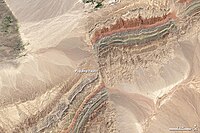
Photo from wikipedia
Several recent moderate-magnitude (Mw > 7) earthquakes, such as the 2015 Gorkha, Nepal, ruptured only the deep (>15 km depth) portions of megathrust faults, leaving the updip sections unbroken. Here… Click to show full abstract
Several recent moderate-magnitude (Mw > 7) earthquakes, such as the 2015 Gorkha, Nepal, ruptured only the deep (>15 km depth) portions of megathrust faults, leaving the updip sections unbroken. Here we investigate the effects of geometrical and frictional variations at depth on the stress accumulation and release in ramp-flat structures using 2-D finite element models. Our results show that ramp-flat structures allow for faster but lower shear stress accumulation with increasing dip of the deep ramp section while increasing frictional strength of the faults allows more stress accumulation. These factors lead to earlier yet smaller failures of the ramp followed by larger and less frequent failures affecting the shallow section. Our models thus suggest that the dynamics of strain reservoirs are related to both the frictional strength and dips of ramp-flat megathrust structures, and the failure time of the shallow fault section is affected by the stress regime at the deep fault segment. Plain Language Summary Many recent earthquakes only rupture in deep (>15 km depth) with the shallow portion of the fault unbroken in a longer time, including the case of the 2015 Mw 7.8 Gorkha Nepal earthquake in the central Himalayan arc. A few historical earthquakes seem also rupture only the deep portion, with much stress unreleased in the shallow portion as a stress “reservoir.” It is unclear how these phenomena are related to fault friction and geometry properties. We used numerical models to study the influences of these properties on stress accumulation during the interseismic period and on the time of final coseismic break. We found that comparing to shallow-dipping fault, steepdipping fault can cause faster stress accumulation but is capable of sustaining lower stress in total, so it tends to break in a shorter time. On other hand, stronger frictional strength allows more stress accumulation in a longer time before the earthquake. In this way, the shallow portion of a fault with low dip angle and high frictional strength can be very stable in a long time and even absorbs stresses from earthquakes of the deep portion. So the shallow portion of this kind of fault is capable of hosting a very large earthquake.
Journal Title: Geophysical Research Letters
Year Published: 2018
Link to full text (if available)
Share on Social Media: Sign Up to like & get
recommendations!